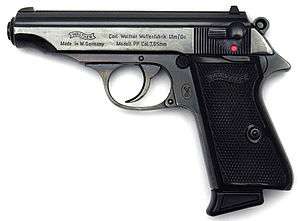Walther PP
| Walther PP | |
|---|---|
|
Original Walther PP pistol. | |
| Type | Semi-automatic pistol |
| Place of origin | Germany[1] |
| Service history | |
| In service | 1935–1992 |
| Used by | See Users |
| Wars | World War II |
| Production history | |
| Designer | Carl Walther Waffenfabrik |
| Designed | 1929 |
| Manufacturer | Carl Walther GmbH Sportwaffen |
| Produced | 1929–present |
| Variants | PPK, PPK-L, PPKS, PP-Super and PPK/E |
| Specifications | |
| Weight |
665 g (23.5 oz) (PP 9×17mm Short/.380 ACP) 660 g (23 oz) (PP 7.65×17mm Browning SR/.32 ACP) 675 g (23.8 oz) (PP .22 LR) 590 g (21 oz) (PPK 9×17mm Short/.380 ACP) 590 g (21 oz) (PPK 7.65×17mm Browning SR/.32 ACP) 560 g (20 oz) (PPK .22 LR) 635 g (22.4 oz) (PPK/S 9×17mm Short/.380 ACP) 630 g (22 oz) (PPK/S 7.65×17mm Browning SR/.32 ACP) 645 g (22.8 oz) (PPK/S .22 LR) 480 g (17 oz) (PPK-L 7.65×17mm Browning SR/.32 ACP) 450 g (16 oz) (PPK-L .22 LR) 780 g (28 oz) (PP-Super) |
| Length |
170 mm (6.7 in) (PP) 155 mm (6.1 in) (PPK) 156 mm (6.1 in) (PPK/S) 165 mm (6.5 in) (PPK-L) 176 mm (6.9 in) (PP-Super) |
| Barrel length |
98 mm (3.9 in) (PP) 83 mm (3.3 in) (PPK, PPK/S, PPK-L) 92 mm (3.6 in) (PP-Super) |
| Width |
30 mm (1.2 in) (PP, PPK/S, PPK-E) 25 mm (1.0 in) (PPK) 35 mm (1.4 in) (PP-Super) |
| Height |
109 mm (4.3 in) (PP) 100 mm (3.9 in) (PPK) 110 mm (4.3 in) (PPK/S) 113 mm (4.4 in) (PPK-E) 124 mm (4.9 in) (PP-Super) |
|
| |
| Cartridge |
7.65×17mm Browning SR (.32 ACP) 9×17mm Short (.380 ACP) .22 Long Rifle 6.35×15mm Browning SR (.25 ACP) 9×18mm Ultra (PP-Super) |
| Action | Straight blowback |
| Muzzle velocity |
256 m/s (840 ft/s) (PP 9×17mm Short/.380 ACP) 320 m/s (1,049.9 ft/s) (PP 7.65×17mm Browning SR/.32 ACP) 305 m/s (1,000.7 ft/s) (PP .22 LR) 244 m/s (800.5 ft/s) (PPK/PPK/S 9×17mm Short/.380 ACP) 308 m/s (1,010.5 ft/s) (PPK/PPK/S/PPK-L 7.65×17mm Browning SR/.32 ACP) 280 m/s (918.6 ft/s) (PPK/PPK/S/PPK-L .22 LR) 325 m/s (1,066.3 ft/s) (PP-Super) |
| Feed system |
Magazine capacity: PP: 10+1 (.22 LR), 8+1 (.32 ACP) 7+1 (.380) PPK: 8+1 (.22 LR), 7+1 (.32 ACP) 6+1 (.380). |
| Sights | Fixed iron sights, rear notch and front blade |
The Walther PP (Polizeipistole, or police pistol) series pistols are blowback-operated semi-automatic pistols, developed by the German arms manufacturer Walther.[2]
It features an exposed hammer, a traditional double-action trigger mechanism,[3] a single-column magazine, and a fixed barrel that also acts as the guide rod for the recoil spring. The series includes the Walther PP, PPK, PPK/S, and PPK/E.
Various PP series are manufactured in either Germany, France, or the United States.[4] Since 2002, the PPK variant is solely manufactured by Smith & Wesson in Houlton, Maine, United States, under license from Carl Walther GmbH Sportwaffen. In the past, this particular model has been manufactured by Carl Walther in its own factory in Germany, as well as under licenses by Manurhin in Alsace, France, and by Interarms in Alexandria, Virginia, US.
The PP and the PPK were among the world's first successful double action semi-automatic pistols and were widely copied, but are still made by Walther. The design inspired other pistols, among them the Soviet Makarov, the Hungarian FEG PA-63, the American Accu-Tek AT-380 II, and the Argentinian Bersa Thunder 380. The PP and PPK were both popular with European police and civilians, for being reliable and concealable. During World War II, they were issued to the German military, including the Luftwaffe, as well as the police.[1]
PP series
The original PP (Polizeipistole) was released in 1929.[1] It was designed for police use and was used by police forces in Europe in the 1930s and later.[1] The semi-automatic pistol operated using a simple blowback action.[1] The PP was designed with several safety features, some of them innovative, including an automatic hammer block, a combination safety/decocker and a loaded chamber indicator.[1]
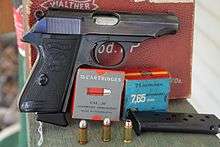
PPK
The most common variant is the Walther PPK, a smaller version of the PP with a shorter grip, barrel, frame and reduced magazine capacity. A new, two-piece wrap-around grip panel construction was used to conceal the exposed back strap. The smaller size made it more concealable than the original PP and hence better suited to plainclothes or undercover work. It was released in 1930.
"PPK" is an abbreviation for Polizeipistole Kriminalmodell (Police Pistol Detective Model), "kriminal" referring to the police detective (criminal) division.[3] Adolf Hitler shot and killed himself with his PPK (a 7.65mm/.32 ACP) in the Führerbunker in Berlin.[5] South Korean dictator Park Chung-hee was shot and killed by Kim Jae-gyu, using the Walther PPK. The Walther PPK pistol is famous as fictional secret agent James Bond's gun in many of the films and novels: Ian Fleming's choice of the Walther PPK directly influenced its popularity and its notoriety.[6][7] Fleming had given Bond a .25 Beretta 418 pistol in early novels, but switched to the PPK in Dr. No on the advice of firearms expert Geoffrey Boothroyd.[7][8][9]
Singer Elvis Presley owned a silver-finish PPK, inscribed "TCB" ("Taking Care of Business").[10]
PPK/S
The PPK/S was developed following the enactment of the Gun Control Act of 1968 (GCA68) in the United States, the pistol's largest market.[11] One of the provisions of GCA68 banned the importation of pistols and revolvers not meeting certain requirements of length, weight, and other "sporting" features into the United States. The PPK failed the "Import Points" test of the GCA68 by a single point. Walther addressed this situation by combining the PP's frame with the PPK's barrel and slide to create a pistol that weighed slightly more than the PPK.[3] The additional ounce or two of weight of the PPK/S compared to the PPK was sufficient to provide the extra needed import points.
Because United States law allowed domestic production (as opposed to importation) of the PPK, manufacture began under license in the U.S. in 1983; this version was distributed by Interarms. The version currently manufactured by Walther Arms in Fort Smith, Arkansas has been modified by incorporating a longer grip tang (S&W calls it "extended beaver tail"),[12] better protecting the shooter from slide bite, i.e., the rearward-traveling slide's pinching the web between the index finger and thumb of the firing hand, which could be a problem with the original design for people with larger hands or an improper grip, especially when using "hotter" cartridge loads. The PPK/S is made of stainless steel.[3]
The PPK/S differs from the PPK as follows:
- Overall height: 104 mm (4.1 in)
- Weight: the PPK/S weighs 51 g (1.8 oz) more than the PPK
- The PPK/S magazine holds one additional round, in both calibers.[12]
The PPK/S and the PPK are offered in the following calibers: .32 ACP (with capacities of 8+1 for PPK/S and 7+1 for PPK); or .380 ACP (PPK/S: 7+1, PPK: 6+1). The PPK/S is also offered in .22 LR with capacity of 10+1.
PPK-L
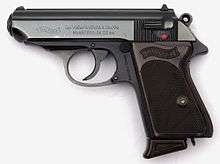
In the 1950s, Walther produced the PPK-L, which was a light-weight variant of the PPK. The PPK-L differed from the standard, all steel PPK in that it had an aluminium alloy frame. These were only chambered in 7.65mm Browning (.32 ACP) and .22 LR because of the increase in felt recoil from the lighter weight of the gun. All other features of the postwar production PPK (brown plastic grips with Walther banner, high polished blue finish, lanyard loop, loaded chamber indicator, 7+1 magazine capacity and overall length) were the same on the PPK-L.
PP Super
First marketed in 1972, this was an all-steel variant of the PP chambered for the 9×18mm Ultra cartridge. Designed as a police service pistol, it was a blowback operated, double-action pistol with an external slide-stop lever and a firing-pin safety. A manual decocker lever was on the left side of the slide; when pushed down, it locked the firing pin and released the hammer. When the 9×19mm Parabellum was chosen as the standard service round by most of the German police forces, the experimental 9mm Ultra round fell into disuse. Only about 2,000 PP Super pistols were sold to German police forces in the 1970s, and lack of sales caused Walther to withdraw the PP Super from their catalogue in 1979.[13]
PPK/E
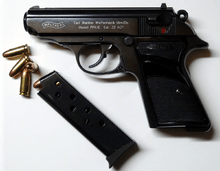
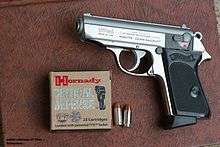
At the 2000 Internationale Waffen-Ausstellung (IWA - International Weapons Exhibition) in Nuremberg, Walther announced a new PPK variant designated as the PPK/E.[14][15] The PPK/E resembles the PPK/S and has a blue steel finish; it is manufactured under license by FEG in Hungary. Despite the resemblance between the two, certain PP-PPK-PPK/S parts, such as magazines, are not interchangeable with the PPK/E. Official factory photographs do not refer to the pistol's Hungarian origins. Instead, the traditional Walther legend ("Carl Walther Waffenfabrik Ulm/Do.") is stamped on the left side of the slide. The PPK/E is offered in .22 LR, .32 ACP, and .380 ACP calibers.
Manufacturing
Walther's original factory was located in Zella-Mehlis in the "Land" (state) of Thuringia. As that part of Germany was occupied by the Soviet Union following World War II, Walther was forced to flee to West Germany, where they established a new factory in Ulm. For several years following the war, the Allied powers forbade any manufacture of weapons in Germany. As a result, in 1952, Walther licensed production of the PP series pistols to a French company, Manufacture de Machines du Haut-Rhin, also known as Manurhin. The French company continued to manufacture the PP series until 1986.
In 1978, Ranger Manufacturing of Gadsden, Alabama was licensed to manufacture the PPK and PPK/S; this version was distributed by Interarms of Alexandria, Virginia. This license was eventually canceled. Starting in 2002, Smith & Wesson (S&W) began manufacturing the PPK and PPK/S under license. In February 2009, S&W issued a recall for PPKs it manufactured for a defect in the hammer block safety.[16]
Walther currently builds PPK and PPK/S pistols for the US Market at their factory in Fort Smith, AR.[17]
Users
-
 Bangladesh: Special Security Force.[18]
Bangladesh: Special Security Force.[18] -
 Burkina Faso: PP variant.[19]
Burkina Faso: PP variant.[19] -
 Central African Republic: PP variant.[19]
Central African Republic: PP variant.[19] -
 Chad: PP variant.[19]
Chad: PP variant.[19] -
 Republic of the Congo: PP variant.[19]
Republic of the Congo: PP variant.[19] -
 Denmark: PPK variant. Danish Police used a 7.65mm version.[20]
Denmark: PPK variant. Danish Police used a 7.65mm version.[20] -
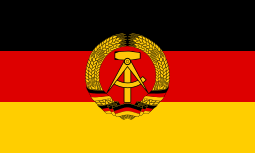 East Germany: A close copy was produced after World War II.[21]
East Germany: A close copy was produced after World War II.[21] -
 France: All Walther PP and variants were produced after World War II by Manurhin until 1986.[21]
France: All Walther PP and variants were produced after World War II by Manurhin until 1986.[21] -
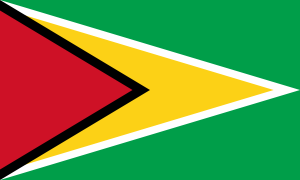 Guyana: PPK variant.[19]
Guyana: PPK variant.[19] -
 Hungary: A close copy was produced locally after World War II. A Hungarian version called the PA-63 (9×18mm Makarov) is still in service.[21]
Hungary: A close copy was produced locally after World War II. A Hungarian version called the PA-63 (9×18mm Makarov) is still in service.[21] -
 Indonesia: PPK variant is used by Komando Pasukan Katak (Kopaska) tactical diver group and Komando Pasukan Khusus (Kopassus) special forces group.[22]
Indonesia: PPK variant is used by Komando Pasukan Katak (Kopaska) tactical diver group and Komando Pasukan Khusus (Kopassus) special forces group.[22] -
 Madagascar: PP variant.[19]
Madagascar: PP variant.[19] -
 Mali: PP variant.[19]
Mali: PP variant.[19] -
 Mauritius: PP variant.[19]
Mauritius: PP variant.[19] -
.svg.png) Nazi Germany[21]
Nazi Germany[21] -
 Niger: PP variant.[19]
Niger: PP variant.[19] -
 Romania: A close copy was produced locally after World War II.[21]
Romania: A close copy was produced locally after World War II.[21] -
 Senegal: PP variant.[19]
Senegal: PP variant.[19] -
 Seychelles: PP variant.[19]
Seychelles: PP variant.[19] -
 South Korea: PP variant.
South Korea: PP variant. -
 Sweden: Walther PP. Was in use by Swedish Police until early/mid 2000s.,[23][24]
Sweden: Walther PP. Was in use by Swedish Police until early/mid 2000s.,[23][24] -
 Togo: PP variant.[19]
Togo: PP variant.[19] -
 Turkey: A close copy was produced locally after World War II.[21]
Turkey: A close copy was produced locally after World War II.[21] -
 United Kingdom: Royal Air Force - L66A1 .22 LR and L47A1 7.65mm Walther PP.[3]
United Kingdom: Royal Air Force - L66A1 .22 LR and L47A1 7.65mm Walther PP.[3] -
 United States: Produced locally and used by various police forces.[25]
United States: Produced locally and used by various police forces.[25]
See also
- Bersa Thunder 380
- List of pistols
- Makarov PM
- Type 64 pistol
- Pistol Carpați Md. 1974
- Table of handgun and rifle cartridges
References
- 1 2 3 4 5 6 Bishop, Chris (2002). The Encyclopedia of Weapons of World War II. Sterling Publishing Company, Inc. ISBN 978-1-58663-762-0.
- ↑ "About Walther". Walther Arms. Retrieved 5 June 2014.
- 1 2 3 4 5 "Walther PP and PPK self-loading pistols (Germany) - Jane's Infantry Weapons". Janes.com. 2012-02-28. Archived from the original on March 2011. Retrieved 2012-11-07.
- ↑ "Customer Support". Walther America. Retrieved 2012-11-07.
- ↑ Fischer (2008) p. 47 "...Günsche stated he entered the study to inspect the bodies, and observed Hitler ...sat...sunken over, with blood dripping out of his right temple. He had shot himself with his own pistol, a PPK 7.65."
- ↑ A.E. Hartink, The Complete Encyclopedia of Pistols and Revolvers, page 368
- 1 2 "James Bond's Walther PPK". CIA Museum. 2007-11-08. Archived from the original on January 9, 2008. Retrieved 15 January 2015.
- ↑ "Time Out: The Guns of James Bond". BBC. September 16, 1964. Retrieved 16 January 2015.
- ↑ Macintyre, Ben (2 February 2012). For Your Eyes Only: Ian Fleming and James Bond. A&C Black. p. 114. ISBN 978-1-4088-3064-2.
- ↑ "Entertainment The King of all auctions". BBC. September 6, 1999. Retrieved 16 January 2015.
- ↑ Hogg 1945:164
- 1 2 "PPK/S Pistol .380ACP". Smith & Wesson. Archived from the original on September 11, 2008.
- ↑ "Modern Firearms - Walther PP Super". World.guns.ru. Retrieved 2012-11-07.
- ↑ "IWA2000". CyberShooters.org. Retrieved 2008-05-04. External link in
|publisher=(help) - ↑ "If Reliability Counts...The New Walther PPK/E" (PDF). Carl Walther Sportwaffen GmbH. Retrieved 2008-05-04.
- ↑ "Walther PPK PPKS Safety Recall - Smith & Wesson". Smith-wesson.com. Retrieved 2012-11-07.
- ↑ http://www.waltherarms.com/handguns/ppk/ppk-ppks
- ↑ "Walther PPK Pistol". Retrieved 2011-01-09.
- 1 2 3 4 5 6 7 8 9 10 11 12 Jones, Richard D. Jane's Infantry Weapons 2009/2010. Jane's Information Group; 35 edition (January 27, 2009). ISBN 978-0-7106-2869-5.
- ↑ "The use of police firearms in Denmark" (PDF). politi.dk. Retrieved 2015-02-21.
- 1 2 3 4 5 6 "Modern Firearms - Walther PP & PPK". World.guns.ru. Retrieved 2012-11-07.
- ↑ "Kopassus & Kopaska - Specijalne Postrojbe Republike Indonezije" (in Croatian). Hrvatski Vojnik Magazine. Archived from the original on 2010-08-22. Retrieved 2010-06-12.
- ↑ "Walther PP, Swedish Contract". Panchogun.com. Retrieved 2012-11-07.
- ↑ "Jakt & Jägare". Jaktojagare.se. 2008-01-25. Retrieved 2016-10-16.
- ↑ Marchington, James (2004). The Encyclopedia of Handheld Weapons. Lewis International, Inc. ISBN 1-930983-14-X.
Notes
- Fischer, Thomas (2008). Soldiers Of the Leibstandarte. J.J. Fedorowicz Publishing, Inc. ISBN 978-0-921991-91-5.
- Hogg, Ian V. (1979). Guns and How They Work. New York: Everest House. ISBN 0-89696-023-4.
- Josserand, M.H.; Stevenson, J.A. (1972). Pistols, Revolvers, and Ammunition. New York: Bonanza Books (A division of Crown Publishers, Inc.). ISBN 0-517-16516-3.
External links
| Wikimedia Commons has media related to Walther PPK. |
- Walther (Germany)
- American Walther site
- Walther PP/PPK instruction manual
- Walther PP spare parts drawing
- Walther PPK/PPK-L spare parts drawing
- Walther PPK/S spare parts drawing
- Walther PPK/E exploded view
- Modern Firearms
- Walther PP on GunsTribune
